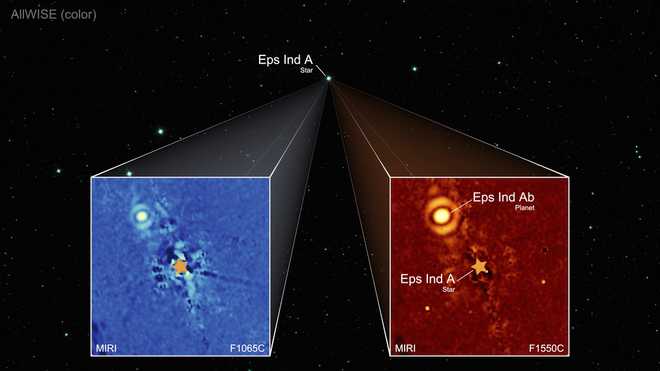A “super Jupiter” has been spotted orbiting a nearby star by the Webb Space Telescope, and it has a super orbit.Related video above: First photo from Japan’s lunar landerThe planet is about the same diameter as Jupiter, but six times as massive. It also has a hydrogen-rich atmosphere, like Jupiter’s.One big difference: It takes this planet more than a century, perhaps 250 years, to orbit its star. It’s 15 times farther from its star than Earth is from the Sun.Scientists have long suspected that a large planet orbits this star 12 light-years away, but not nearly as massive or as far from its star. A light-year is 9.3 trillion kilometers. These new observations show that the planet orbits the star Epsilon Indi A, which is part of a three-star system. An international team led by Elisabeth Matthews of the Max Planck Institute for Astronomy in Germany collected the images last year and published the results Wednesday in the journal Nature. The astronomers observed the incredibly old and cool gas giant directly — a rare and tricky feat — by obscuring the star through the use of a special shading device on Webb. By blocking out starlight, the planet stood out as a pinpoint of infrared light. The planet and star are 3.5 billion years old, 1 billion years younger than our own solar system, but still considered old and brighter than expected, Matthews said. The star is so close and bright to our own solar system that it is visible to the naked eye in the southern hemisphere. Don’t bet on life, though. “It’s a gas giant with no hard surface or oceans of liquid water,” Matthews said in an email. It’s unlikely that this solar system is home to more gas giants, she said, but small rocky worlds could be lurking there. Jupiter-like worlds can help scientists understand “how these planets evolve on giga-year timescales,” she said. The first planets outside our solar system — dubbed exoplanets — were confirmed in the early 1990s. NASA’s tally now stands at 5,690 as of mid-July. The vast majority of them were detected using the transit method, in which a fleeting dip in the brightness of stars, repeated at regular intervals, indicates an orbiting planet. Telescopes in space and on the ground are searching for even more planets, especially ones that might be similar to Earth. Launched in 2021, NASA and the European Space Agency’s Webb telescope is the largest and most powerful astronomical observatory ever placed in space. ___ The Associated Press Health and Science Department receives support from the Howard Hughes Medical Institute’s Science and Educational Media Group. The AP is solely responsible for all content.
A “super Jupiter” has been spotted around a nearby star by the Webb Space Telescope — and it has a super orbit.
Related video above: First photo of Japan’s lunar lander
The planet is about the same diameter as Jupiter, but its mass is six times greater. Its atmosphere is also rich in hydrogen, like Jupiter’s.
One major difference: it takes this planet more than a century, perhaps even 250 years, to orbit its star. The distance between it and its star is 15 times greater than the distance between Earth and the Sun.
Scientists have long suspected that a large planet orbits this star 12 light-years away, but it wasn’t nearly as massive or as far from its star. A light-year is 9.3 billion kilometers. These new observations show that the planet orbits the star Epsilon Indi A, which is part of a three-star system.
An international team led by Elisabeth Matthews of the Max Planck Institute for Astronomy in Germany collected the images last year and published their results Wednesday in the journal Nature.
Astronomers were able to directly observe this incredibly old and cool gas giant—a rare and tricky feat—by obscuring the star with a special shading device on Webb. By blocking the star’s light, the planet stood out as a pinpoint of infrared light.
The planet and star are 3.5 billion years old, 1 billion years younger than our own solar system, but are still considered old and brighter than expected, Matthews said.
The star is so close and bright to our solar system that it is visible to the naked eye in the southern hemisphere.
But don’t bet on life.
“This is a gas giant with no hard surface or liquid water oceans,” Matthews said in an email.
It’s unlikely that this solar system is home to more gas giants, she said, but small rocky worlds could be lurking there.
Jupiter-like worlds can help scientists understand “how these planets evolve on giga-year time scales,” she said.
The first planets outside our solar system, called exoplanets, were confirmed in the early 1990s. NASA had counted 5,690 of them as of mid-July. The vast majority of them were detected using the transit method, which involves observing a temporary decrease in the brightness of stars, repeated at regular intervals, indicating the presence of a planet in orbit.
Telescopes in space and on the ground are searching for new planets, especially those that might resemble Earth.
Launched in 2021, NASA and the European Space Agency’s Webb telescope is the largest and most powerful astronomical observatory ever placed in space.
___
The Associated Press Health and Science Department receives support from the Howard Hughes Medical Institute’s Science and Educational Media group. The AP is solely responsible for all content.
